Related Research Articles
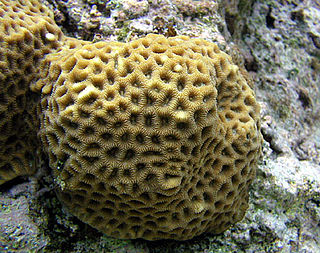
Brain coral is a common name given to various corals in the families Mussidae and Merulinidae, so called due to their generally spheroid shape and grooved surface which resembles a brain. Each head of coral is formed by a colony of genetically identical polyps which secrete a hard skeleton of calcium carbonate; this makes them important coral reef builders like other stony corals in the order Scleractinia. Brain corals are found in shallow warm water coral reefs in all the world's oceans. They are part of the phylum Cnidaria, in a class called Anthozoa or "flower animals". The lifespan of the largest brain corals is 900 years. Colonies can grow as large as 1.8 m (6 ft) or more in height.

Avena strigosa is a species of grass native to Europe. It has edible seeds and is often cultivated as animal feed in southern Brazil. It is sometimes reported as a weed.

Acronicta strigosa, the marsh dagger, is a moth of the family Noctuidae. It is distributed through most of Europe, east to the Caucasus, northern China, Korea and Japan.

Galathea strigosa is a species of squat lobster in the family Galatheidae. It is found in the northeast Atlantic Ocean, from the North Cape to the Canary Islands, and in the Mediterranean Sea and Red Sea. It is edible, but not fished commercially. It is the largest squat lobster in the northeast Atlantic, reaching a length of 90 millimetres (3.5 in), or a carapace length of 53 mm (2.1 in), and is easily identified by the transverse blue stripes across the body.
Gemmocystis is a genus of apicomplexans.

Lissanthe strigosa, commonly known as peach heath, is a species of flowering plant in the family Ericaceae, and is endemic to south-eastern Australia. It is a shrub with linear to lance-shaped leaves and white to pink, cylindrical flowers.
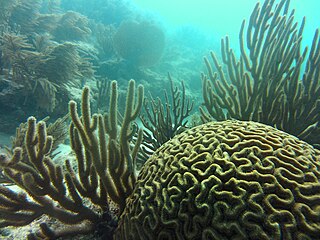
Pseudodiploria strigosa, the symmetrical brain coral, is a colonial species of stony coral in the family Mussidae. It occurs on reefs in shallow water in the West Atlantic Ocean and Caribbean Sea. It grows slowly and lives to a great age.

Myrmecopsis strigosa is a moth of the subfamily Arctiinae. It was described by Herbert Druce in 1884. It is found in Mexico and Guatemala. The wingspan is about 25 mm.

Colobotheini is a tribe of longhorn beetles of the subfamily Lamiinae.

Colobothea is a genus of longhorn beetles of the subfamily Lamiinae.
Colobothea destituta is a species of beetle in the family Cerambycidae. It was described by Bates in 1865.
Colobothea fasciatipennis is a species of beetle in the family Cerambycidae. It was described by Linsley in 1935. It is known from Honduras and Panama.
Colobothea flavimacula is a species of beetle in the family Cerambycidae. It was described by Voet in 1806. It is known from South America.
Colobothea subcincta is a species of beetle in the family Cerambycidae. It was described by Laporte in 1840. It is known from Brazil.
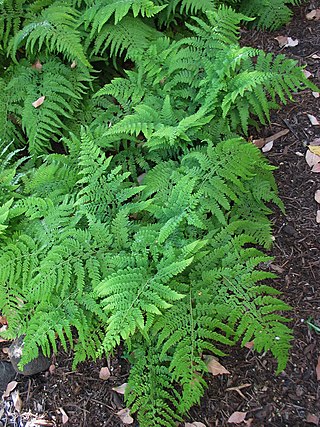
Microlepia strigosa, known as hay-scented fern, lace fern, rigid lace fern and palapalai, is a fern indigenous to the Hawaiian islands and is also native to other parts of the tropics and subtropics including India and Malaysia. This fern belongs to a group of about seventy Microlepia species in the bracken or hay-scented fern family (Dennstaedtiaceae). There are two indigenous species and a hybrid found in the main Hawaiian Islands. It is also known by the botanical names: Davallia hirta, Davallia setosa, Davallia strigosa, Dicksonia kaulfussiana, Dicksonia strigosa, Microlepia hirta, Microlepia setosa, Stenoloma tenuifolium, Trichomanes strigosum. It has coarse, light to medium green fronds which can grow to more than 3 ft (0.9 m) long.
Caladenia strigosa is a plant in the orchid family Orchidaceae and is endemic to South Australia. It is a ground orchid with a single leaf and a single greenish-cream flower with fine reddish streaks. It grows in sandy soil in shrubland.

Clostera strigosa, the striped chocolate-tip or drab tent-maker moth, is a species of moth in the family Notodontidae. It was first described by Augustus Radcliffe Grote in 1882 and it is found in North America.
Muranotrichea is a class of free-living marine anaerobic ciliates, that, together with the classes Parablepharismea and Armophorea, form a major clade of obligate anaerobes within the SAL group.
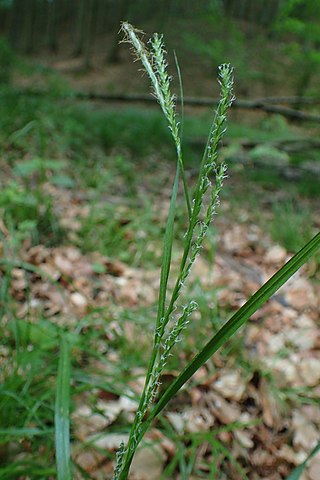
Carex strigosa, the thin-spiked wood sedge, is a species of flowering plant in the genus Carex, native to Europe and the Caucasus region. Its diploid chromosome number is 2n=66.
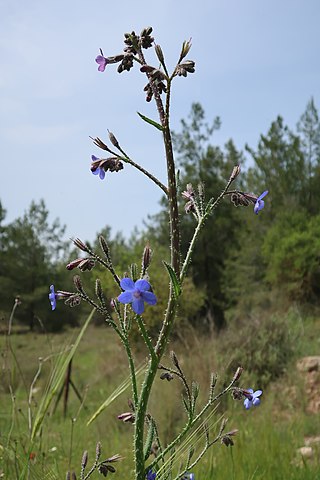
Anchusa strigosa is a non-succulent species of herbaceous plants in the Boraginaceae family endemic to the Eastern Mediterranean regions, particularly, Greece, Turkey, Lebanon, Israel, Jordan, and Iran. It is known widely by its common names of strigose bugloss and prickly alkanet.
References
- ↑ BioLib.cz - Colobothea strigosa. Retrieved on 8 September 2014.